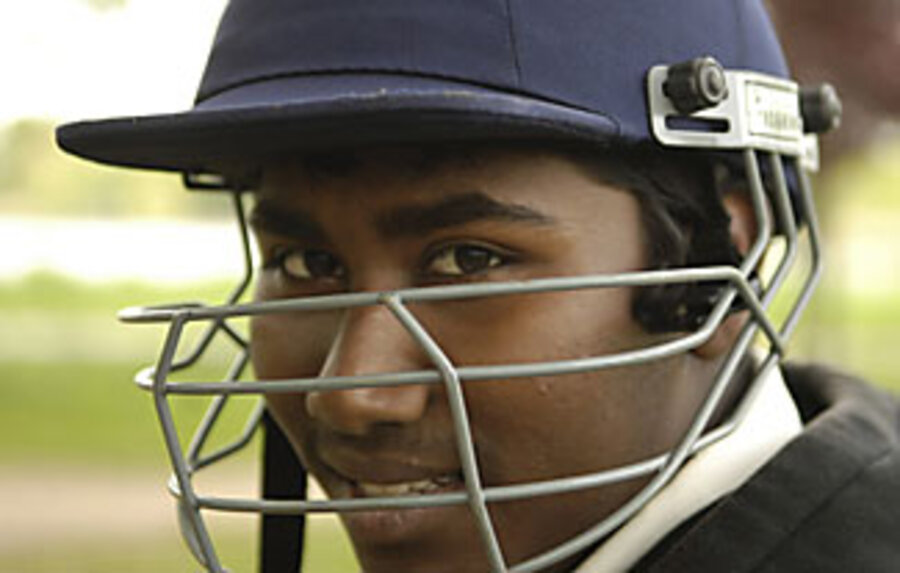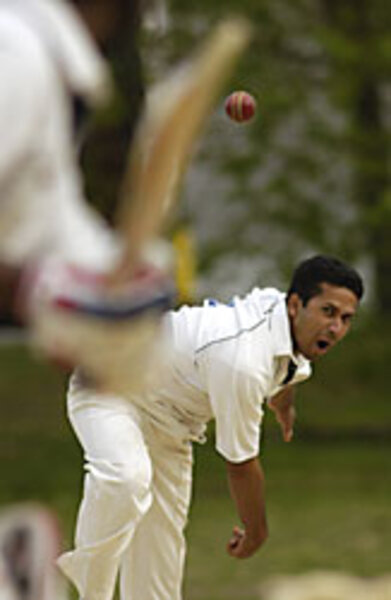Cricket's new wicket: American high schools
Loading...
| New York
Not long after Saiful Islam moved from Bangladesh to Brooklyn in 2005, his father – a formidable man of some 70 years – asked Saiful if he'd considered buying a cellphone. Yes, of course, answered the teenager. Besides the fact that most of his friends had mobiles, one of his own could be handy if he ever found himself in trouble in the hardscrabble section of Queens where he goes to school.
"But I do not think you should have one," his father advised. "Because what if it rings on the cricket pitch? You will be distracted and you won't be able to play your best."
That his father's logic would make any sense at all to a teenager in America – and, indeed, Saiful did agree with his father – is a measure of the power that the sport of cricket holds among immigrants from the former British Empire. Much as Little League or high school football grips American childhood, cricket, too, is a way of life in immigrant neighborhoods: for the homesick, for the athletes, for the would-be warriors, for the doting parents on the sidelines. Every afternoon, the parks in Queens and Brooklyn fill with Caribbean, Pakistani, Bangladeshi, and Indian immigrants who battle through matches on islands of sand and dead grass, flanked by noisy skateboarders and the blare of boomboxes.
The game, says Saiful, is a way "to remember home. It is my game." The dark-haired 17-year-old with a quick, easy grin has been immersed in cricket for most of his life. He played on a Queens club team for three seasons; before that, he competed in Bangladesh, sweating out the hot summers and waiting through the winters for the season to start again. He watches cricket on YouTube and wanders to the Southeast Asian restaurants in Jackson Heights, Queens, to watch the matches live on big screens.
And now he plays in the nation's first high school cricket league. He's the vice captain of the Lions, the Newcomers High School squad from Jamaica, Queens that is favored to win next week's championships.
Saiful rarely sleeps, in thrall to a cricket schedule that leaves little room for family or friends. Some weeks, he leaves school to play cricket, arrives back home at 10 p.m., speeds through his homework – "I have to do it," he says – and then sets his alarm for 5:15 a.m.
Last year, Saiful canceled a flight home to Bangladesh to see his mother and brother when an unexpected match was scheduled. "This summer, I have to go back or I'll be in big trouble."
• • •
The idea of a high school cricket league was first floated two years ago by Eric Goldstein. chief executive officer of school support services for the New York City Department of Education.
"There were a lot of blank stares," he recalls.
Modern cricket – a sport with some similarities to baseball – originated in England, although its most ardent fans are now scattered through the remnants of the British Empire. (Some place cricket as the second most popular pastime in the world, behind soccer.) Played on a strip of dirt, surrounded by an oval field, the game requires the brawn to hit a fast-moving leather ball with a thick wooden bat. It also requires a sense of strategy and patience foreign to fans of fast-paced American sports. Matches in professional cricket stretch for days. And for the uninitiated, the arcane rules of the game are impenetrable.
But students at Newcomers – and other schools across Queens and Brooklyn – had been playing informal matches for decades. Dominic Gomes, captain of the Lions and a senior, says, "We'd do it for fun anyway, in the backyard, or on the playground. We'd split the cost of a bat, and all get together and have big matches."
Mr. Goldstein's coup was to institutionalize that passion: to provide umpires, new equipment, and proper pitches, in a league filled with like-minded students. "We thought we'd try starting the league with four teams," he says. "We ended up with 14. Hundreds of kids. There was this overwhelming interest ... with a level of enthusiasm you don't see a lot these days."
Says Roman Koyes, a Bengali immigrant on the Lions squad: "I've been playing since I was about 7. I think this is true of most of the team.... So when the tryouts were announced, everyone was scrambling for a chance."
Decked out in white uniforms, and wielding shiny new bats, the Lions immediately rung up a string of victories, outscoring opponents by dozens of runs and finishing regular season play 9-2.
"I'll give a lot of credit to these kids – it's a game of serious mental focus and they've got that," says Newcomers' coach Christina Cavaliere, the only female coach in the league and a self-described "Bronx girl" who grew up watching the Yankees.
Still, challenges abound. Most of the team arrived here within the past few years, and many members have shaky English. They speak to each other rapidly in a host of languages, and Coach Cavaliere often runs the risk of losing their attention. And because she is a self-taught cricketer, she has had to learn on the job. But, she still gives credit to her expert charges: "This team was going places. I always knew that."
• • •
"Six!" screams Mustafa Afzaly. "Six!"
For a moment, the ball arcs lazily through the gray sky, and the Lions – assembled on a bench at the edge of the field – rise to their feet willing the ball to hit the outfield fence mid-air, which would earn six runs. It's been a grim match, in some ways a hopeless match, and six runs, smiles Dominic Gomes, "would really, really help."
The ball lands in the grass at the edge of the field, and then smacks into the fence – earning only four runs. Dominic sits back down, his head hanging down between his knees.
Like Saiful, Dominic is a skilled athlete, and is frequently mentioned as a prospect for the national team. "What people don't understand is that good players have bad games," he says. "Take football. A good football player will be good most of the time, but a good cricket player has bad matches. We are having a bad match. That's OK," he continues, as a teammate wanders past him on his way to take a swing for the Lions.
The team has played valiantly, but the boys from Richmond Hill High School (Queens) have played more skillfully. They're already cheering, anticipating a quick win a couple of outs away.
Amdadhul Chowdhury, a slight kid, swallowed by the uniform that hangs loosely over his shoulders, frowns. "Don't hit it in the air," he whispers. "Hit it on the ground. I've told him. Hit it on the ground."
Dominic clamps a hand on Amdadhul's shoulder, consoling him: "No one is perfect."
As the game winds down and the losing Lions wander off the field, he explains that, "Cricket is cricket. You can't argue with the rules of cricket. But being a captain is a nervous feeling.... You're worried about your team. You try to be happy, but you give your support, and then you keep playing, and try not to let them see you worry."
"It's tough for them," says Cavaliere. "There's a lot of pressure. Some parents understand cricket, but some don't. The teachers certainly don't. [The kids] have got these crazy schedules and they put so much into the game."




